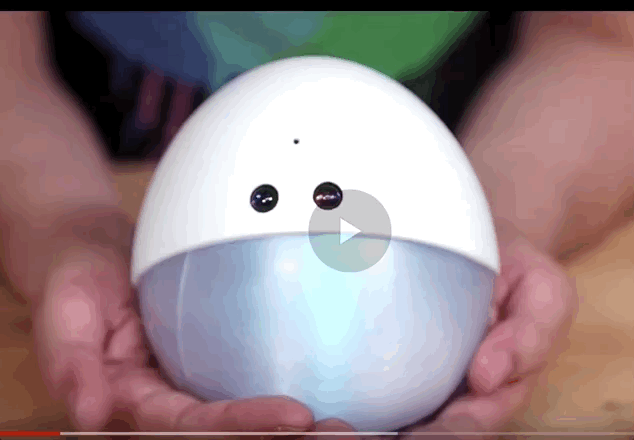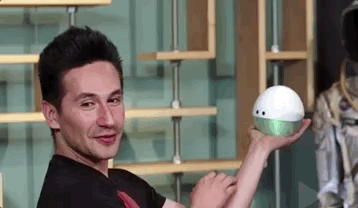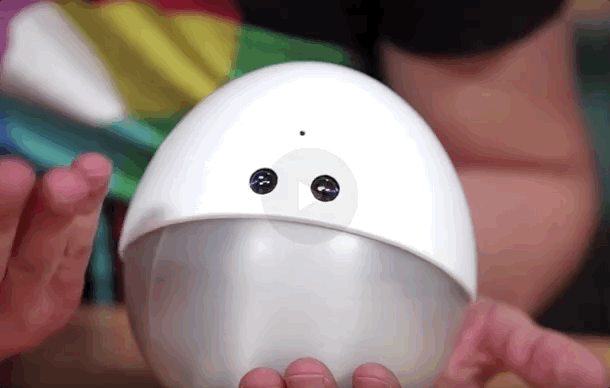Summary
 Pixar animator Alonso Martinez’s Mira (2017) is an expressive “baby robot”. Mira is part of a family of robots by Martinez, crafted to expound upon the way characters are made to feel alive in movies by making them not only something a consumer can watch but someone they can interact with. The simple-looking little robot smoothly follows people around with its blinking inquisitive eyes and makes an 8-bit chortle when a face disappears and then reappears as part of a game of peek-a-boo.
Pixar animator Alonso Martinez’s Mira (2017) is an expressive “baby robot”. Mira is part of a family of robots by Martinez, crafted to expound upon the way characters are made to feel alive in movies by making them not only something a consumer can watch but someone they can interact with. The simple-looking little robot smoothly follows people around with its blinking inquisitive eyes and makes an 8-bit chortle when a face disappears and then reappears as part of a game of peek-a-boo.
Theory and Context
 Inspired by previous robots like R2D2 which communicate through emotional rather than verbal language, Martinez set out to “bring characters to life” off the screen. By using simple organic shapes and fluid responsive motions, he created a canvas which allowed people to find emotion in the robot’s subtle movements and responses without using any explicit language. In search of natural ways people communicate without words, Martinez looked to the games like “peek-a-boo” which parents play with their kids before they’re able to speak. These “unspoken games” are a central feature of Mira’s emotional means of communication which Martinez says “really allows you to project yourself and be like ‘Is it sad? Is it mad? Is it happy?’ with very small, kind of little design cues”.
Inspired by previous robots like R2D2 which communicate through emotional rather than verbal language, Martinez set out to “bring characters to life” off the screen. By using simple organic shapes and fluid responsive motions, he created a canvas which allowed people to find emotion in the robot’s subtle movements and responses without using any explicit language. In search of natural ways people communicate without words, Martinez looked to the games like “peek-a-boo” which parents play with their kids before they’re able to speak. These “unspoken games” are a central feature of Mira’s emotional means of communication which Martinez says “really allows you to project yourself and be like ‘Is it sad? Is it mad? Is it happy?’ with very small, kind of little design cues”.
Mechanism and Design

At her core, Mira is an egg-shaped robot meant to evoke the nature of a baby, which can rotate its head around in three directions (roll, pitch, yaw) to look around its environment and find visual cues in it. The head’s in-line three-axis movement is achieved by using a microservo-powered floating-joint mechanism inspired by a video game controller. This mechanism allows Mira to follow people around using facial-recognition data from a pin-hole camera mounted between the eyes which is processed using OpenCV on a Raspberry Pi. As it looks around its environment and collects these data, Mira blinks. This blinking is controlled by a thin OLED panel behind each eye with a hemi-spherical orb glued onto it. If it sees something worth responding to, Mira is able to make beeps using a piezo-electric buzzer, and change the tint of its body using a single bright RGB LED.
Takeaway
The force which makes Mira such a powerfully expressive robot is the old adage “less is more”. By using subtly to exploit human psychology, Mira is able to steer well clear of the uncanny valley many robots fall into and come off as a warm and playful.
Watch
Links
Alonso Martinez’s 3D-Printed Animated Robots!
Sources
All media clips and content sourced from:
Martinez, Alonso, and Sean Charlesworth. “Alonso Martinez’s 3D-Printed Animated Robots!” YouTube, Tested, 15 June 2017, youtu.be/0vfuOW1tsX0. Accessed 12 Sept. 2018.

Leave a Reply
You must be logged in to post a comment.